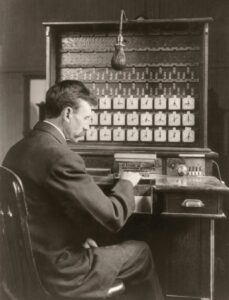Back to: Computer Studies JSS1
Welcome to class!
In today’s class, we shall be talking about an important topic – the hollerith census machine. Please enjoy the class!
Hollerith Census Machine

The Hollerith Census Machine, also known as the tabulating machine, was an electromechanical device invented by Herman Hollerith in the late 1880s to automate the tabulation of data, particularly for the 1890 U.S. Census. Hollerith’s invention revolutionized data processing and paved the way for the development of modern computers.
Background
Prior to the Hollerith Census Machine, the process of tabulating data was manual and time-consuming. Clerks would painstakingly count and record data from handwritten or printed documents, a process that was prone to errors. The growing population of the United States in the late 19th century made this process even more challenging, as the amount of data to be processed increased exponentially.
Herman Hollerith, a young inventor working for the U.S. Census Bureau, recognized the need for a more efficient method of data processing. Inspired by the use of punched tickets in the railroad industry, Hollerith developed a system that used punched cards to store and process data.
How the Hollerith Census Machine Worked
Hollerith’s system consisted of three main components:
- Punch cards: Rectangular cards made of stiff paper with rectangular holes arranged in rows and columns. Each hole represented a specific piece of data, such as a person’s age, gender, or occupation.
- Keypunch machine: A device used to punch holes in the cards. Operators would enter data by pressing keys that corresponded to the different holes on the cards.
- Tabulating machine: An electromechanical device that read the holes on the cards and counted and sorted the data.
The Hollerith Census Machine offered several advantages over manual data processing methods:
- Speed: The machine could process data much faster than human clerks, significantly reducing the time required to complete the census.
- Accuracy: The machine was less prone to errors than manual methods, as it was not subject to human fatigue or mistakes.
- Versatility: The machine could be used to process a wide variety of data, not just census information.
Hollerith’s invention had a profound impact on data processing and computing. It revolutionized the way data was collected, stored, and analyzed, and it paved the way for the development of early computers.
The Hollerith Census Machine was used for subsequent U.S. Censuses and was adopted by government agencies and businesses worldwide. Hollerith later founded the Tabulating Machine Company, which merged with other companies to form the Computing-Tabulating-Recording Company (CTC), which eventually became International Business Machines (IBM).
The Hollerith Census Machine was a landmark invention that transformed data processing and helped set the stage for the development of modern computers. It demonstrated the power of automation and paved the way for a new era of data-driven decision-making.
We have come to the end of today’s class. I hope you enjoyed the class!
In case you require further assistance or have any questions, feel free to ask in the comment section below, and trust us to respond as soon as possible. Cheers!
Question Time:
- What is the Hollerith Census Machine and how did it revolutionize data processing?
- Describe the three main components of the Hollerith Census Machine system.
- Explain how the Hollerith Census Machine encoded data onto punched cards.
- What were the key benefits of using the Hollerith Census Machine over manual data processing methods?
